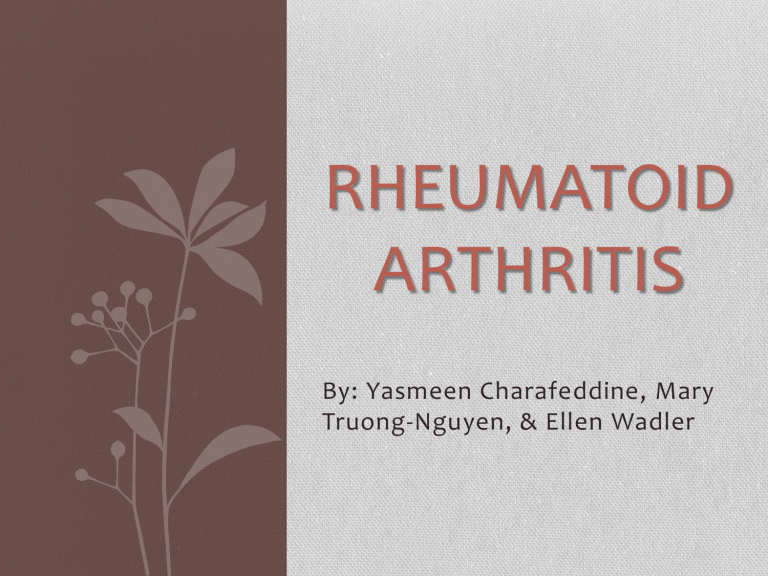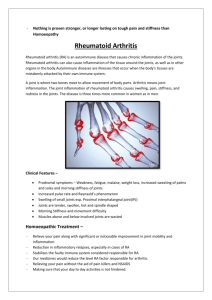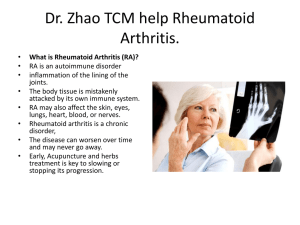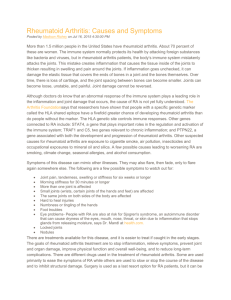Rheumatoid Arthritis

RHEUMATOID
ARTHRITIS
By: Yasmeen Charafeddine, Mary
Truong-Nguyen, & Ellen Wadler
General Definition
• Rheumatoid arthritis is an autoimmune chronic inflammatory disorder
• The immune system attack’s its own body tissues, in this case, the joints, starting with the small joints in the hands and feet
• With progression, RA eventually results in joint deformity and bone erosion
Symptoms
• Of the joints:
• Tenderness
• Swelling
• Lasting stiffness
• Rheumatoid nodules = firm bumps of tissue under the skin of the arms
• Occurs in the more aggressively diseased patients
• Other:
• Fatigue, fever, weight loss
• Symptoms come and go and can vary in severity
• Increased activity period = flare
• Decreased activity period = relative remission
Rheumatoid nodule
Causes
• The immune system attacks the synovium
• Synovium = the lining of the membranes surrounding the joints
• Inflammation thickens the synovium
• The thickening will eventually invade and destroy the cartilage and bone in a joint
• The joint is held together with tendons and ligaments which lose elasticity (become weaker and stretch) with the progression of the disease
• With time, the joint loses shape and alignment, causing the characteristic image of rheumatoid arthritis
What is affected?
• In the beginning symptoms occur in:
• Smaller joints attaching fingers to hands and toes to feet
• With progression symptoms spread to:
• Knees
• Ankles
• Elbows
• Hips
• Shoulders
Diagnostic Tests
• Hard to detect in early stages
• Signs and symptoms of early stages are similar to other diseases
• During physical exam, joints will be checked for swelling, redness, and warmth
• Reflexes and muscle strength are also checked
• Blood tests
• Look for elevated erythrocyte sedimentation rate (ESR) shows presence of inflammatory processes in body
• Also looks for rheumatoid factor and anti-cyclic citrullinated peptide
(anti-CCP) antibodies
• X-rays
• Used to track the progression of the arthritis
Treatment
• As of now, there is no cure
• Various drugs can be used to reduce inflammation, relieve pain, and prevent/slow the joint damage
• Some have potentially serious side effects, so the ones with fewest side effects are prescribed first
• Physical therapy can teach the patient how to protect the joints
• If the damage is already severe, surgery may be necessary
Drugs
• Nonsteroidal anti-inflammatory drugs (NSAIDs)
• Relieves pain and reduces inflammation
• Over the counter = Advil, Motrin, Aleve, etc.
• Stronger NSAIDs must be prescribed
• Side effects: stomach irritation, heart problems, liver/kidney damage, ringing in the ears
• Steroids
• Corticosteroids = reduce inflammation and pain as well as slow the damage in the joints (ex. Prednisone)
• Side effects: bone thinning, cataracts, weight gain, diabetes
• These are very strong and prescribed to relieve acute symptoms; the goal is to eventually taper off the medication
Drugs (cont.)
• Disease modifying antirheumatic drugs (DMARDs)
• Slow the progression of RA and can save the joints and other tissues from permanent damage
• Examples: methotrexate, ieflunomide, hydroxychloroquine, sulfasalazine, minocycline, etc.
• Side effects: liver damage, bone marrow suppression, severe lung infections
• Immunosuppressants
• Tames the immunes system because it is the immune system that is out of control in RA
• Examples: azathioprine, cyclosporine, cyclophosphamide
• Side effects: increase the patient’s susceptibility to infections
Drugs (cont.)
• Tumor necrosis factor (TNF)-alpha inhibitors
• TNF-alpha is an inflammatory substance naturally produced by the body
• Inhibitors reduces pain, stiffness, tenderness, and swelling
• Examples: etanercept, infliximab, adalimumab, golimumab, certolizumab
• Side effects: increased risk of serious infections, congestive heart failure, certain cancers are more potentially possible
• Other drugs
• Target a variety of processes involved with inflammation
• Examples: anakinra, abatacept, rituximab, tocilizumab
• Side effects: itching, severe abdominal pain, headache, runny nose, sore throat
Surgery
• Procedures
• Total joint replacement = removing the damaged parts of the joint and inserting a metal or plastic prosthesis
• Tendon repair = tendons can loosen and rupture so the surgeon may be able to repair them
• Joint fusion = a joint can be surgically fused to stabilize or realign a joint; also for pain relief if replacement is not an option
• Surgery is a last option when medications have failed to prevent or slow the progression of joint damage
Effects of Writing About Stressful Experiences on
Symptom Reduction in Patients With Asthma or
Rheumatoid Arthritis
• Research has demonstrated that writing about emotionally traumatic experiences has beneficial effects in healthy individuals
• Objective of experiment: To determine if writing about stressful life experiences affects disease status in patients with asthma or rheumatoid arthritis
• After 4 months of treatment, RA patients showed improvements in overall disease activity
• Addressing patients' psychological needs produces both psychological and physical health benefits
• http://jama.jamanetwork.com/article.aspx?ar
ticleid=189437
Pre-Stage
• The Prodromal Stage
• The early symptoms which indicate the start of the disease before specific symptoms occur
• Includes pain or stiffness in a single joint
• Stiffness in a joint and ambiguous aching are symptoms called
“fibrositis”
• Ganglion in the wrist
• Raynaud's phenomenon = a condition where cold temperatures or strong emotions can cause blood vessels to spasm which block blood flow to the fingers, toes, ears, and nose
Mild Stage
• Stages of Functional Capacity
• Stage 1: Can complete normal activities without handicap
• Stage 2: Normal activities can still be completed but discomfort found at some joints and limited motion in one or more joints
Moderate Stage
• Moderate to severe symptoms appear six months to a year or more after the early symptoms appear
• The same body parts affected in the prodromal stage may not be affected in the later stages
• Severe shoulder stiffness may reappear in the wrist joint
• Symptoms may disappear but than reappear in more aggressive forms
Severe Stage
• Stages of Functional Capacity
• Stage 3: Limited only to self-care and can complete little or none of the usual activities
• Stage 4: Little to no self-care. Bed ridden or confined to a wheel chair
Prognosis
• Course of disease varies greatly
• Some people have mild short-term symptoms while for others it is progressive for life
• Daily living activities are impaired in most individuals
• After 5 years of disease, approximately 33% of suffers will not be working
• After 10 years, approximately half will have substantial functional disability
• Mortality:
• RA reduces lifespan by 5-10 years
Relationship to other problems:
• RA can increase risk of developing:
• Osteoporosis
• RA medication can trigger significant bone loss
• Pain and loss of join function caused by RA can result in inactivity which increases osteoporosis risk
• Carpal tunnel syndrome
• If RA affects your wrists, the inflammation can compress the nerve that serves most of your hand and fingers.
• Heart problems
• RA can increase risk of hardened and blocked arteries and inflammation of the sac that encloses your heart
• Lung disease
• RA can increase inflammation and scarring of lung tissue
• These complications can lead to death in the severe cases
Random extra facts:
• Rheumatoid arthritis occurs with the same frequency in both sexes
• However remission is more common in men
• The chronic form is more common in women
• It occurs in 1-2% of males and 2-5% of females
• The joints most likely affected are metacarpophalangeals, wrists, proximal interphalangeals, knees, ankles, metatarsophalangeals, and shoulders
• It most commonly begins between the ages of 40 and 60
• Smoking increases the risk of developing the disease
• Having family members with the disease increases the risk of developing the disease
• The onset of rheumatoid primarily occurs in the winter
Osteoarthritis versus RA
• Osteoarthritis is a common form of arthritis
• involves the wearing away of the cartilage that caps the bones in joints
• Rheumatoid arthritis is when the synovial membrane that protects and lubricates joints becomes inflamed, causing pain and swelling.
Works Cited
• Jacoby, R. K., M. I. Jayson, and J. Alan Cosh. "Onset, Early Stages, and
Prognosis of Rheumatoid Arthritis: A Clinical Study of 100 Patients with 11year Follow-up." British Medical Journal (1973): 96-100. Web.
• Smyth JM, Stone AA, Hurewitz A, Kaell A. Effects of Writing About
Stressful Experiences on Symptom Reduction in Patients With Asthma or
Rheumatoid Arthritis: A Randomized Trial. JAMA. 1999;281(14):1304-1309. doi:10.1001/jama.281.14.1304.
• Staff, Mayo Clinic. "Definition." Mayo Clinic. Mayo Foundation for Medical
Education and Research, 02 Nov. 2011. Web. 20 Nov. 2012.
<http://www.mayoclinic.com/health/rheumatoid-arthritis/DS00020>.
• "Raynaud's Phenomenon." PubMed Health. U.S. National Library of
Medicine, 28 June 2011. Web. 20 Nov. 2012.
<http://www.ncbi.nlm.nih.gov/pubmedhealth/PMH0001449/>.
• "Rheumatoid Arthritis Prognosis." Rheumatoid Arthritis Prognosis. N.p., n.d. Web. 20 Nov. 2012. <http://www.newsmedical.net/health/Rheumatoid-Arthritis-Prognosis.aspx>.
• "WebMD Rheumatoid Arthritis Guide - Better Information for Better
Health." WebMD. WebMD, n.d. Web. 20 Nov. 2012.
<http://www.webmd.com/rheumatoid-arthritis/guide/default.htm>.









